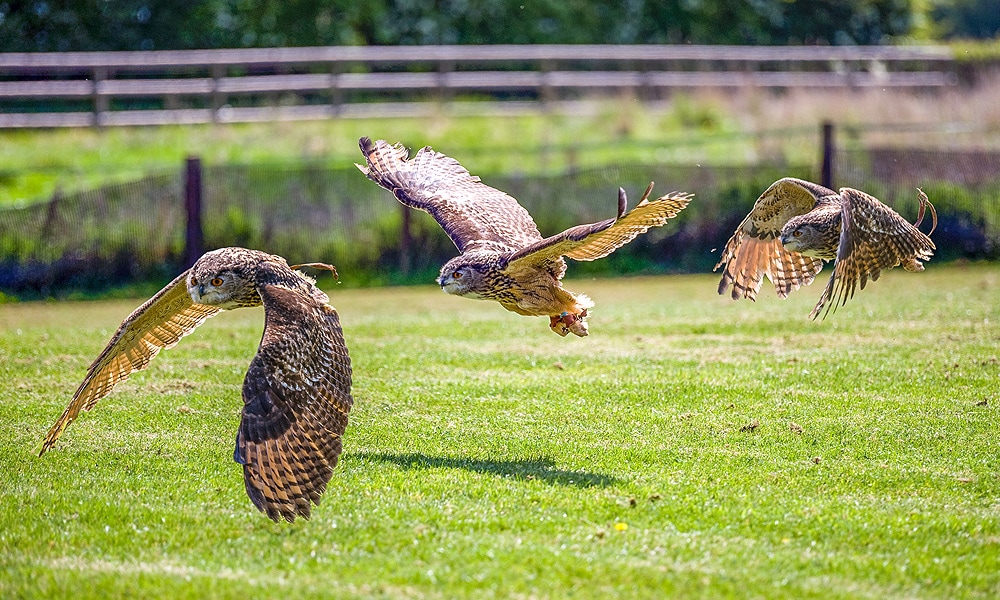Here at World Birds, we’re big fans of wildlife of all kinds, but owls are a particular favorite. Their mysterious beauty and natural adaptations make them unique amongst raptors and many birders go out of their way to attract owls to their gardens.
While I may be a certified owl-lover, I do recognize that not everyone feels the same. Many people are disturbed by the noise that owls make or upset by the thought that an owl might be stalking their beloved pet. In this article, we’ll clear up a few common myths and misconceptions about owls and provide some tools to help you deter owls humanely if that is still your goal.
Will owls eat my dog?
One of the main reasons people worry about owls in their backyards is the concern that owls may hunt and attack smaller pets outdoors. This is not impossible but it is generally not very likely either. Owls do attack dogs and cats on occasion, though it is more often to try and chase a potential predator away from their nesting area rather than to grab a meal.
When they do hunt very small cats and dogs, your pet is usually too heavy for them to carry off. Of course, pets will sustain injuries in an encounter like this, but again– this is uncommon.
The thing is, owls are not the only predators you need to worry about when you allow small pets outdoors unsupervised. There are much larger raptors that are more inclined to eat a cat (and much more likely to succeed) not to mention coyotes that frequently eat smaller pets, and plenty of other mammals like raccoons that may not be likely hunt your pets but may spread deadly diseases.
As much as “Will an owl eat my cat?” is an unnerving question, it’s important to make sure that this is the right question to be asking.
The point is, when you allow your pets outside unsupervised, you adopt a certain level of risk. They become part of the local ecosystem. An outdoor cat may kill hundreds of rodents, lizards, and songbirds during its time outside. Once in a while, it might find itself on the other side of the food chain. Owls are one of the less likely candidates to bring this about.
Are owls a protected species?
If you’re still concerned about owls in your yard and determined to do something about it, your next step should be to look into your local laws. In the United States, ALL owls are protected by the Migratory Bird Treaty Act. If you live in another country, you’ll want to take your own national and local laws into account.
The Migratory Bird Treaty Act forbids pursuing, hunting, catching, or taking owls, or trying to do any of these things. So step one of your plan to get rid of owls must be to recognize that you CANNOT attempt to harm them.
If owls are disturbing your backyard chickens or you’re worried about your small pet, it is your job to protect your animals. Supervise your pets and secure livestock to keep them safe before you start worrying about how to remove owls from your property. This will work better than any owl deterrent.
What can I do about an owl keeping me up at night?
My advice– invest in some earplugs. Owls live in suburban areas because they were here first. Sleep is very important and I absolutely sympathize with the frustration of interrupted sleep, but the owls that you’re hearing may not even be in your own yard.
Owl hoots can be heard for miles and are usually used to either establish a territory or solidify bonds between a mated pair. Trying to eliminate this sound from the night air is a bit like trying to eliminate moonlight. It’s there for a reason and there’s not much you can do except try to block it out from your own home. Instead of getting rid of owls, focus on ways to make yourself more comfortable.
Soundproof your space with acoustic panels or try using a white noise machine to drown out the sounds of owls. All of these methods will be more effective and kinder to your local ecosystem than most owl deterrents.
1. Stop attracting songbirds
If you want to get rid of owls, make your yard a less attractive place for them. Small defenseless birds are dinner for many common owl species. Don’t populate your garden with tasty owl treats. If you have bird’s feeders installed on the tree to attack songbirds, remove them immediately.
Owls also eat rodents, and birdfeeders regularly attract rats and mice. This is another reason to consider why you might try coexisting with the owls first. If owls are hanging out in your yard, they’re likely keeping pests at bay. You may find that without owls you notice a higher presence of mice and rats.

Still, if you want to keep your songbird feeders out, there are options to explore. Try a specialized ultra-sonic bird repellent. You can generate specific frequencies to target certain birds without harming other animals.
The sound waves can’t be detected by human ears. These devices are effective if kept on for an extended period. Try to discuss your case of getting rid of owls with the device providers to get specific advice.
Don’t be surprised if this method has the unintended consequence of driving out some of your favorite songbirds.
2. Create high noises and sounds
Owls typically avoid any sort of contact with human beings. If you find out that owls have taken up residence somewhere around your property, you can encourage them to move on by make noises. Yelling, shouting, and clapping is what owls are afraid of and making your presence known as a human is likely to make your yard a lot less hospitable.
Increasing human activities in the presence of owls can make them go away, but you can’t be active all night. To deter owls at night, you can try homemade noise-making setups near your chicken coop and porches. Set out aluminum tin cans tied up together with one loose end.
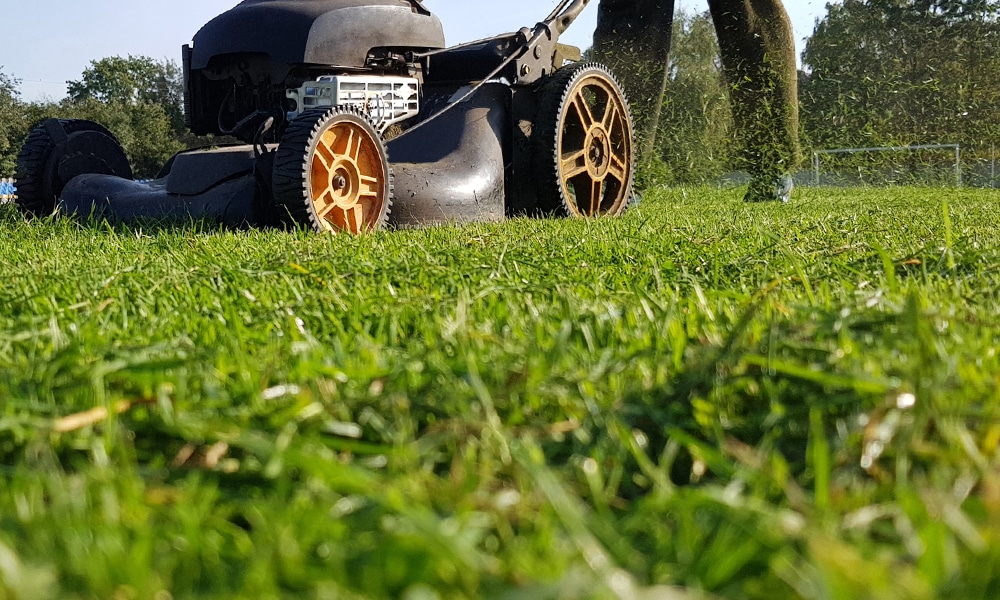
Once again, purchasing one of the best ultrasonic bird repellent devices you can find is a great remote option, but be aware that even with unique frequencies for different birds, a device like this may scare off more than just owls.
3. Use strobe lights to scare owls away
Owls like to hunt in the evening and at night, when their silent wings make them almost impossible to detect. So if your yard removes the cover of darkness that they rely on, you can bet that owls will find it less attractive as a hunting ground. You can do this by adding lights to your surroundings.
Owls hate strobes lights. You can find these devices in a pet shop near you, or you can order them online. This American DJ strobe light is one of the effective strobe lights to scare owls, but a constant strobe light in your yard costs energy and will confuse or repel other animals as well.

If you have livestock, a strobe light may disturb their sleep schedule and lead to harm. This option should only be used after exhausting less disruptive routes.
4. Get a Rooster
Shepherds use sheep dogs to protect their flocks from predators. You can do the same when it comes to protecting your hens and birds from predators such as owls and hawks. Instead of a dog, you need a rooster to keep your chickens safe.
Roosters are both brave and vigilant. They will call out when they see predators, and will even sometimes physically fight off intruders to protect their flock. So, a rooster is a natural choice for protecting chickens.
Be sure to research your local laws before purchasing one, as permits may be required and roosters sometimes fall under different regulations than hens since they’re much noisier.
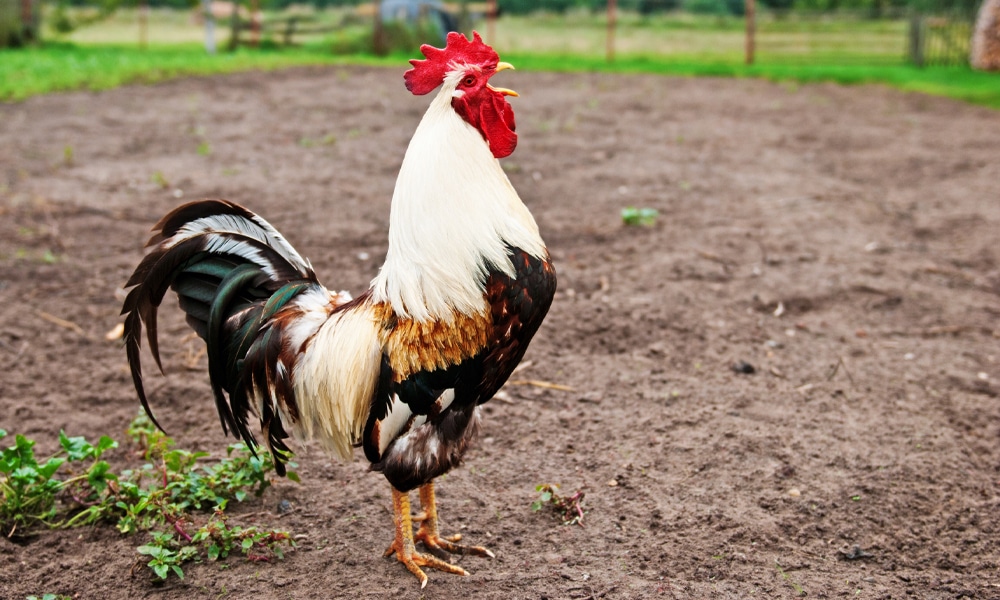
Livestock expert says that 1 rooster is enough per 8-10 hens. Roosters will constantly be on alert, and when owls show up, it will sound the alarm.
I don’t recommend impulsively buying a rooster as a solution to your owl problem unless you’ve done the research and truly want a rooster.
They are noisy animals with specific care requirements like any other pet or livestock. But if a rooster was already on your wish list then go for it. They can be a huge help when it comes to the security of your chickens.
5. Remove nesting options
Another long-term option to get rid of owls is to remove its options for breeding on your property. If owls can’t find any suitable nesting place for their mating, they will go someplace else. Look out for holes in tree trunks and other nooks and crannies that seem like comfortable nest candidates.
If there are already a few nests nearby, DO NOT disturb them. This is illegal and may even be dangerous as owls will defend their nests.

In case of any nearby nests, call wildlife professionals. They will give you the guideline on how to remove the nest safely. They will most likely advise you that nothing can be done unless the nest is on your own property and not in use, but it’s worth making the call.
In the best-case scenario, those professionals can relocate those owls to someplace else.
You may also try providing nest options further away from your bedroom window. Owls regularly use nest boxes, so providing an owl nest box at the far edge of your property may help entice them to set up shop somewhere less disruptive.
6. Remove roosting options
Have a big backyard? Don’t know how to keep owls away from the property? Owls spend all day sitting on the perches. They are ambush predators and can spy on their prey from any high vantage point and will attack as it starts to get dark out.
To make your yard less attractive to owls, remove all perching sites you can find in and around 100 meters of your farm and make sure they are cut down. This is easier said than done as getting rid of perching sites may mean sacrificing some trees and losing both the shade and the lovely songbirds that congregate in your trees.

Avoid unnecessary growth of bushes in your yard. These thick shrubs can provide a hiding place for rats and mice. Owls feed on these rodents; this means they are going to stay around. Don’t let the grass grow too high and shelter potential owl prey.
This way, owls will have less prey to hunt and less reasons to perch in your yard.
7. Place roosting spikes on perching areas
Removing trees and preventing perching areas can be difficult, expensive, and result in a less enjoyable yard overall. Instead, you can plant anti-roosting bird spikes. This is another long-term solution for owl removal. You can find these spikes on the home-improvement store and even online. Bird spikes might look mean but they’re generally considered humane and simply make surfaces less comfortable for birds to perch on.
You can place spikes on tree limbs, windowsills, roofs, and porches. These spikes, once installed, don’t require much maintenance.

Most bird spike strips feature spikes that are flexible and will sit on both smooth and uneven surfaces. Just keep in mind that bird spikes don’t discriminate. Your yard will become less hospitable to all sorts of birds and you may see a reduced presence of songbirds in your garden.
8. Install mirrors to frighten owls
Owls are deeply territorial and will be disturbed by the presence of a strange owl in its territory. Installing mirrors may help frighten owls away. Just don’t be surprised if you see other birds tousling with their reflection.

That said, mirrors may cause other birds to crash into them, the same way they do with windows. A small mirror on its own will probably do more harm than good. Instead, using strips of reflective material is more likely to scare off owls than a mirror is. In this case, it’s the reflected light that bothers owls rather than the image of another owl.
9. Use a hawk or other predator decoy
They might seem like the top of the food chain, but many other animals are known to eat owls. For an owl, another raptor is likely to be one of the biggest threats. Scare owls away by purchasing a predator decoy. Hawk decoys are likely to be the most effective.
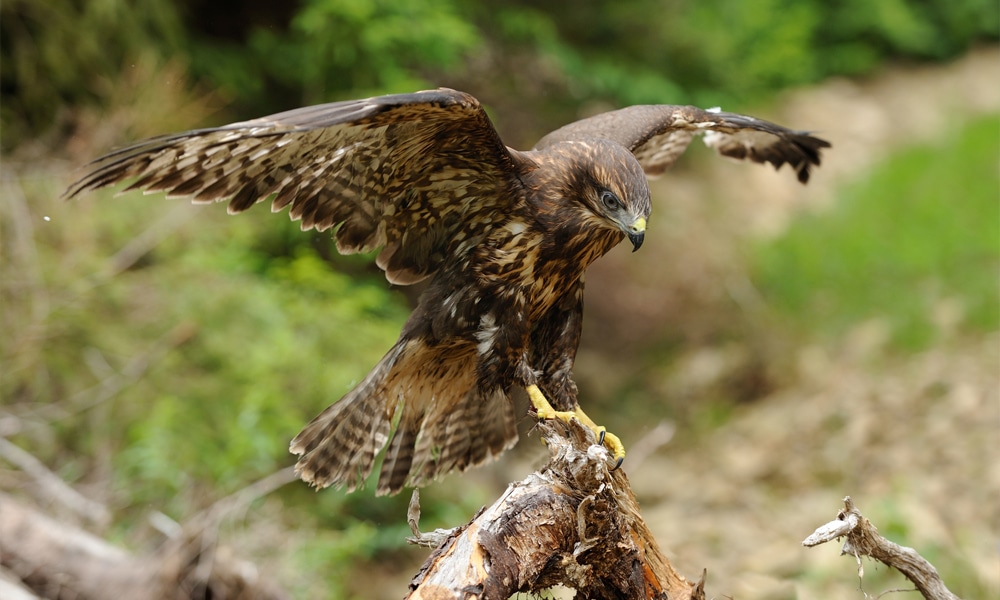
Birds quickly become wise to decoys if they never move. We recommend purchasing a decoy that moves in some may, and occasionally changing its position in your yard to add to the illusion.
Not to sound like a broken record, but you should know that other birds besides owls will also be frightened by the presence of a decoy and may avoid your yard.
10. Protect your livestock
If your concern is that an owl might attack your livestock, your best defense isn’t getting rid of the owl, it’s defending the livestock. Shore up your chicken coop. Look for holes and make sure you use sturdy hardware cloth for the walls of your animal enclosures.
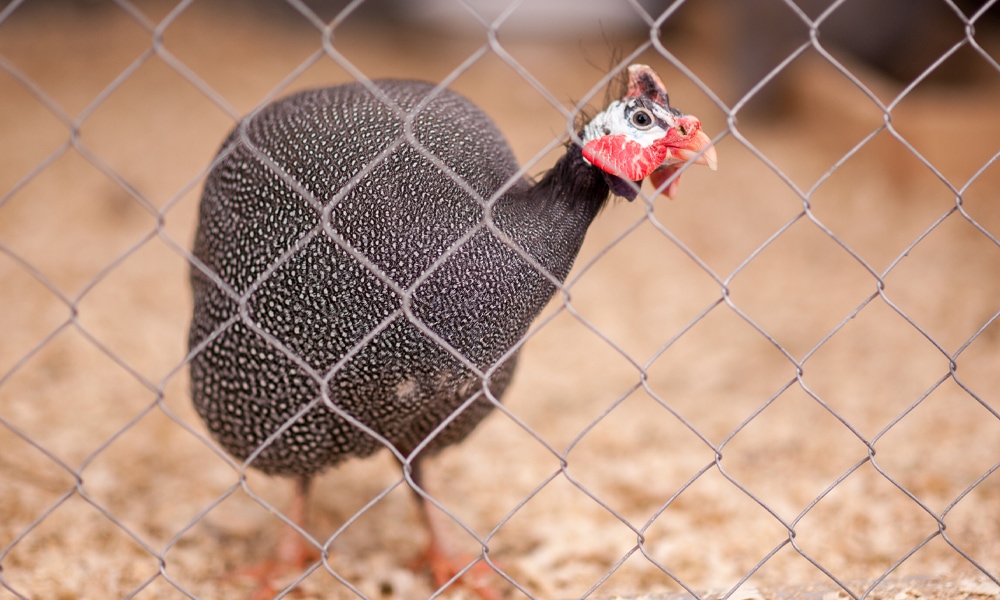
Think like an owl. Make sure your vulnerable chickens are safe inside their coop when evening falls and owls begin hunting. Try setting out reflective materials and bird spikes in the specific areas where your birds are most often loose. A stubborn owl might come back night after night, but it can’t do any harm if your chickens are safe and secure inside their coop come evening.
11. Add a scarecrow
Scarecrows have been trusted to protect farms for thousands of years. You can apply this principle to your own yard, garden, or farm. You can even make your DIY scarecrow from scratch.
Birds will get used to your scarecrow if it never moves, so make sure to move it often.

Up your scarecrow game by placing it over a motion-activated sprinkler to convince the birds that a human is trying to scare them off. Owls are not that smart and should be fooled by a scarecrow, at least temporarily, if it is moved around frequently.
12. Use night lights
Owls hunt in the nighttime. If there is enough light around the property, owls are less likely to appear. If birds and livestock are kept in an outdoor enclosure, then keeping that area lit should help keep your birds safe.

Constant light will disturb your birds and may lead to illness or other issues. We suggest a motion light installed facing away from the interior of your coop.
Related: How Long Do Owls Live? (Owl Life Expectancy)
Final Thoughts
Owls are truly incredible creatures whose presence in your yard likely has unseen benefits that you have yet to notice. But if they’ve become a bother to you, pursuing humane owl control methods is critical. Before taking any action, call your local department in charge of wildlife for recommendations on how to proceed in a way that reduces potential harm and protects you from legal repercussions.

